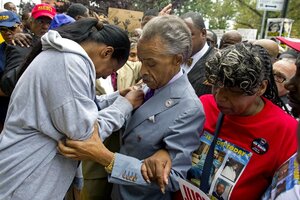Staten Island marchers protest police killing of Eric Garner
Saturday’s event followed a summer of racial unrest tied to the deaths of two black men – Michael Brown and Eric Garner – by police, highlighting the troubled relationship between minority communities and police.

Esaw Garner arrives at the start of a march and rally in the Staten Island borough of New York Saturday. With her at the spot where her husband Eric Garner died in police custody are The Rev. Al Sharpton and Eric Garner's mother Gwen Carr.
Craig Ruttle/AP
STATEN ISLAND, NEW YORK
At the corner of Victory Boulevard and Bay Street in Staten Island, near the sidewalk where Eric Garner was killed by police in July, Tonneda Holmes is chanting with thousands of protesters at the start of a march and rally against the tactics of the NYPD.
"Hands up, don't shoot! Hands up, don't shoot!" is the refrain of the boisterous crowd at the moment – an echo of the protesters in Ferguson, Mo., where police shot and killed Michael Brown just weeks after Mr. Garner's death. Ms. Holmes, a nurse's aide who lives just down the block, is raising her fist as she pushes her 3-year-old daughter Kayla in a stroller amid the throngs.
"I'm here so that justice will be served for the families of these people that were unarmed, you know," says Ms. Holmes, who was an acquaintance of Garner for years. Her 16-year-old son Mark, marching alongside his mother and sister, mentions he plays basketball with Garner's son. "They didn't deserve to die that way, the way that they did," his mother continues.
The energy and emotions ran high throughout the "We Will Not Go Back" march on Saturday, organized by the Rev. Al Sharpton more than a month ago, before the killing of Mr. Brown, an unarmed teen.
The event follows a summer of explosive racial unrest that has gripped the country in the aftermath of the deaths of these two black men at the hands of police, leaving city and national leaders to grapple with the long-troubled relationship between minority communities and police.
Many worried the violence and looting in Ferguson could spill over into Saturday's march. Most local businesses were closed for the day, their "riot gates" shut tight. Police cordoned off the march route with heavy movable fencing, and organizers with bullhorns directed the crowds. The private international consultant MSA Security also patrolled public transportation points with bomb-sniffing dogs.
"I don't care how mad you are," Rev. Sharpton told the crowd during the rally in the afternoon. "Do not undermine the family's fight for justice.... Anybody that acts up we will expose."
Despite the anger among some, many of whom held provocative signs and chanted, "No justice, no peace, no racist police," the mostly-black marchers were an array of families. Elderly grandparents and toddlers alike marched with signs emblazoned with "Justice for Eric Garner," a married father of six. His survivors, including his mother and wife and children, led the march with Sharpton.
Some of the signs were made by a group of community activists and residents, including youth, who met Friday evening to hold an "art build" at the Mount Sinai Center for Community Enrichment in Staten Island.
As protesters arrived in the morning, Ilya Jala and Jennifer Carlo, local residents, stood at a corner near the ferry, handing them their homemade signs. One read, "RIP Eric Garner: Why did you judge me? It was not my time."
"I was born and raised here and I'll be living here for the rest of my life," Ms. Carlo says. "It's unacceptable what the cops are doing to my fellow Staten Islanders, and it's unacceptable that it happens to anyone."
Garner was placed in an apparent chokehold banned by the NYPD, after he resisted his arrest for allegedly selling loose cigarettes, known as "loosies" on the street. New York's medical examiner ruled the death a homicide.
"We need a city where an illegal chokehold is an illegal chokehold," Sharpton said before leading the march, speaking at a morning service at the Mount Sinai United Christian Church in Staten Island. "We're here because we saw a man unarmed taken down in an illegal chokehold, and if you can do it to him, you can do it to any citizen, and we are not going to be silent when it happens."
Protesters marched from the site of Garner’s death to the office of Staten Island District Attorney Dan Donovan, in part to pressure him to charge the officer who Garner in a chokehold with a crime. The officer, Daniel Pantaleo, has been stripped of his gun and placed on desk duty, but the police union insists his restraint was in line with department policy.
District Attorney Donovan announced earlier this week that there was enough evidence to move forward with grand jury proceedings. On Thursday, Sharpton and Garner’s family met with the local U.S. attorney to discuss a possible federal investigation – as is already happening for the Brown family in Ferguson.
“When it happened, we were feeling, we were all just so angry,” says Holmes, Garner’s neighborhood acquaintance. “But at the same time, you know, we all felt that justice would be served because it was all on tape. But so far that hasn't happened.”

